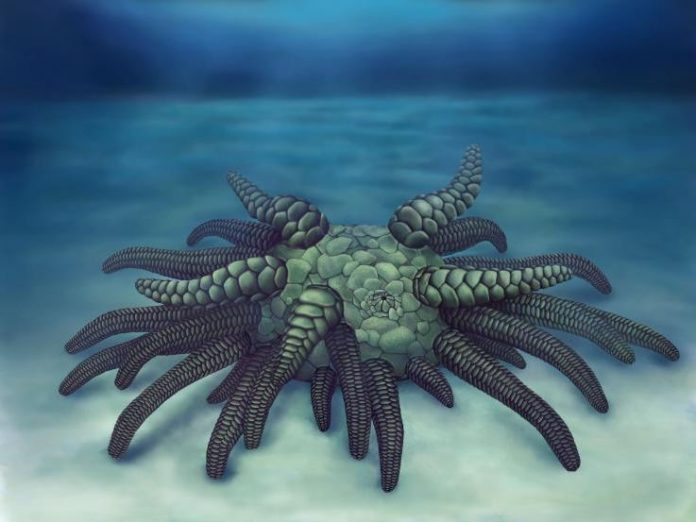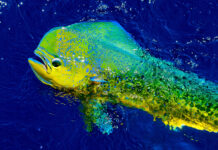An exceptionally-preserved fossil of a 430 million-year-old tentacled sea creature reminded an international team of paleontologists so much of the description given by American science-fiction and horror author H.P. Lovecraft of his creature Cthulhu (pronounced “kuh-THOO-loo”), that they named the new species Sollasina cthulhu. Lovecraft introduced Cthulhu, a bizarre tentacled monster of unknown origin, in his 1926 short story The Call of Cthulhu, where he describes it as, “a monster of vaguely anthropoid outline, but with an octopus-like head whose face was a mass of feelers, a scaly, rubbery-looking body, prodigious claws on hind and fore feet, and long, narrow wings behind.” The anatomical features reconstructed in 3D by the paleontologists reveal that Sollasina is an extinct echinoderm, most closely related to modern sea cucumbers. The skin of echinoderms, including sea cucumbers, sea urchins, crinoids and starfish, is covered for protection with tiny ossicles made of calcium carbonate. A few extant species still retain relatively large plates and also the three-centimeter long body of the extinct species was entirely covered in bony plates, giving the animals a “scaly, rubbery” look. Sollasina also featured 45 tentacles, another typical feature of echinoderms, branching out from a central body. The many tentacles reminded the authors of “the mass of feelers” supposedly surrounding Cthulhu’s mouth. However, unlike Cthulhu, the tentacles of Sollasina weren’t used to swallow human souls, but likely helped the animal crawl around the sea floor of ancient Herefordshire, now part of the UK, as well as passing food to the mouth in the center of the body.
As Lovecraft inspired the authors of the discovery, fossils inspired some elements in Lovecraft’s Cthulhu Mythos. Cthulhu features prominently only in the short story of Call of Cthulhu, however, Lovecraft makes some references to the creature in his later works. At the Mountains of Madness is a science-fiction/horror story published by Lovecraft in 1936. In the story, told in a first-person perspective by geologist William Dyer, one of the few survivors of an expedition to Antarctica, it is suggested that fossil traces of ancient and monstrous creatures were found.
The hollowed layer was not more than seven or eight feet deep but extended off indefinitely in all directions and had a fresh, slightly moving air which suggested its membership in an extensive subterranean system. Its roof and floor were abundantly equipped with large stalactites and stalagmites, some of which met in columnar form: but important above all else was the vast deposit of shells and bones, which in places nearly choked the passage.
Later the expedition discovers even older fossils in 500 million-year-old sedimentary layers. Lovecraft apparently based this part on the real discovery of fossil archaeocyathids in Antarctica, made in 1920 by geologist William Thomas Gordon. Archaeocyathids are an extinct group of sponge-like creatures, believed to be among the oldest animals ever to live on Earth. According to the geological knowledge of Lovecraft’s time, no higher life existed on Earth 500 million years ago. However, Dyer’s expedition discovers the traces of highly evolved creatures among the primitive fossils. Lovecraft only refers to those creatures as the Elder Things and some believe that Cthulhu is related to them. Like the terrifying Cthulhu, the Elder Things predate by millions of years the human race. Lovecraft also suggests in his tales the possibility that his creatures are not yet dead, just sleeping underground, still waiting to be one day unearthed by paleontologists.








